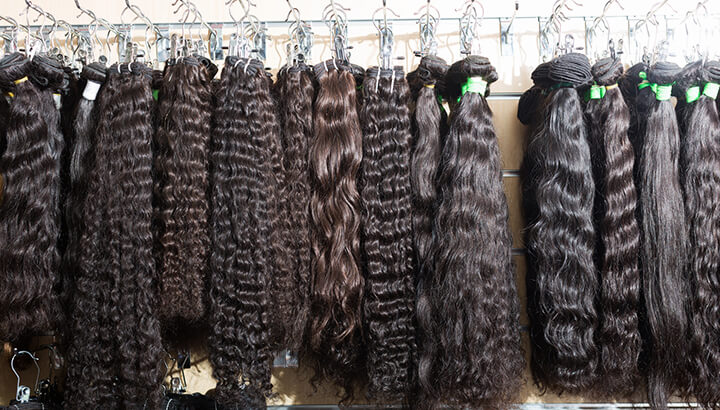
Back in college, when we used to come home from a night out on the town, my roommate would unclip her hair extensions and toss them on the dresser. We used to joke about how creepy they looked sitting there — especially because it was real hair.
For women in the Western world, hair extensions are a quick and easy beauty solution that has turned into a billion dollar industry. After all, why wait for your own hair to grow naturally, when you can seek a more rapid alternative?
Just like the foods on our plate, there’s a disconnect between the origin of hair extensions and the lives that are affected along the way. When you dig deeper to find out how these quick-fix extensions are produced, the last thing you’ll want to do is proudly wear them around town.
Exclusive: Could Bees Help Us With Hair Growth?
Where does the hair come from?
Today, women head to the salon or a beauty supplier to find perfectly designed strands of hair, ready to wear. In order to achieve the most natural-looking hair, women seek “real” human hair extensions — without much thought as to how that hair was obtained.
Controversy surrounding the hair trade has been in effect since the early 1900s, when American news outlets reported the ways in which hair was collected. Whether it was stated that the hair was obtained from sewers or cut off of corpses, the origin was never a positive image.
What was once viewed as grotesque and controversial is now more of a humanitarian issue. Today, the supplied hair has to come from some human being out there, but who?
Taken from the East to supply the West

We’d like to think that the individuals who supply this hair are volunteers. But unfortunately, there’s a much darker side to this industry. While you admire your new locks, a young girl is being exploited and mistreated.
It is not grown and regulated. It is actually bought and essentially stolen. The truth of the matter is, hair is being taken from women in the East to supply the demand in the West — a shocking and sickening reality. It’s a tale of the less fortunate, paving the way for those who can afford the finer things in life.
When heading to the salon, the average women can pay anywhere from $500 to $2000 for hair extensions, whereas the original owner of those locks may get $80, if they’re lucky. In most cases, women will receive around $40, which is enough to purchase rice for nearly two months. Considering that these women would have grown their hair for around three years, it’s a fairly pathetic exchange.
Black gold drives the hair extension craze
Although women throughout India and China feed into this supply and demand cycle, there are rural areas where virgin hair can be found. Meaning, it has never been dyed, blow-dried or straightened. This increases the value. It is so sought after, it’s what’s known as “black gold.”
Thousands of individuals work as agents, traveling to these villages in order to hunt for virgin hair. Young girls are found, a price is agreed upon and then their long ponytails are cut off in a matter of seconds. After these girls are stripped of their beautiful hair, they are left where they were found and their hair is exported to Western consumers.
The invisible chain of labor
While reporting on this subject, NZ Herald stated that the disconnect is more than apparent. And the shocking reality is that women in the West care about the price — not the origin. There’s a lack of social and ethical responsibility. Those who grew the hair, as well as those who are stuck within this chain of labor, are essentially invisible.
While focusing on these women, the most ethically sourced hair comes from temples in Chennai, India, as women willingly shave their heads for religious purposes. Being the most similar to Caucasian hair in terms of texture, it is more valuable in the Western world — yet many salon owners admit they do not charge a premium because no one wants to pay more for an ethically sourced alternative.
China’s “capital of hair”

We are living in a world where consumerism rules with an iron fist. And when individuals in the Western world want something, they want it now. As you can imagine, hair extensions need to be continuously processed in order to meet this demand, as the product itself takes years to grow.
Taihe, China’s “capital of hair” is home to over 400 companies who endlessly process hair. Literally hundreds of ponytails will be poured out in order to be judged. And based on the quality, a price will be offered. As you would expect, “dead” hair sells for less than a freshly cut ponytail.
As reported by one of the agents, less hair is now being sold in China, in comparison to five years ago. This is because fewer people are living in desperation. They no longer need to sacrifice their hair in order to survive. This has resulted in the agents driving further into the countryside to find more rural hair donors.
Girls don’t always consent to hair cuts
There are reports of girls trying to run, as they are dragged back by their parents in order to make the sale. Others sit there in silence, with their heads down — they have experienced this traumatic event before. Some argue that there’s no violence involved and that these families get paid. But like any high-demand commodity, it’s always more grim than it appears.
There have been reports of young girls being held down by gangs, as their hair is cut off. There’s also been reports of children being tricked into giving up their hair in order to receive a toy. It’s disgusting and unfair to say the least, but hair is big money. And like so many questionable actions, greed tends to trump ethics.
The demand for hair extensions
Every week, up to 10,000 extensions are exported to the United States where regulations are fairly lax. After all, it’s considered to be a beauty accessory, not a body part. By the time these extensions reach America, no one really knows whether or not the hair was willingly donated or stolen.
It’s apparent that the attitude of the Western world is a major contributing factor, as so many view this supply and demand chain as a cycle that is simply out of their hands. Although recipients admit that exploitation is more than likely going on, they say that there is little that they can do from their home town.
Supporting a broken industry
When purchasing these extensions, you’re not only supporting the way in which these products are sourced, but also manufactured. Thousands of workers sit inside of factories, some being paid less than $2 an hour. Within just one factory, workers tirelessly sort through thousands of ponytails, producing up to 3.1 miles worth of hair daily — 1,134 miles a year.
Seventy percent of the hair that’s processed in China comes from Chinese girls. However, the final product is often mislabeled as Peruvian or Brazilian to increase the price. Chinese hair is often viewed as lower quality. Of course, women continue to pay top dollar in order to achieve the enhanced beauty and femininity they seek.
In fact, once these extensions make their way through the supply chain, they are worth more than the donors will see in their lifetime. It’s a depressing thought, one that turns my stomach.
Reduce demand to change the system
Now that you know how your hair extensions are harvested, would you still feel beautiful wearing them? With so many controversial issues, once awareness increases, there are some people who will take positive action. But for the most part, life continues as it was. In this case, the rich get richer. The privileged get a new luscious hair style. The poor are left as they were — poor, without the true freedom of choice and little opportunity.
You may think that you cannot personally make a difference, but you can. There’s a reason why these women need to chop off their hair every two to three years — there’s a demand, and we’re creating it.
— Krista Hillis

